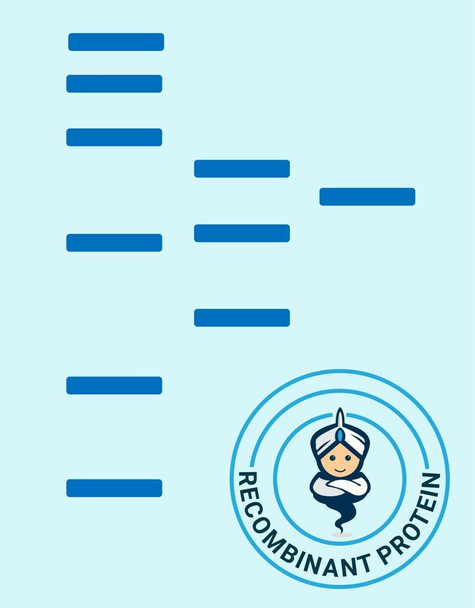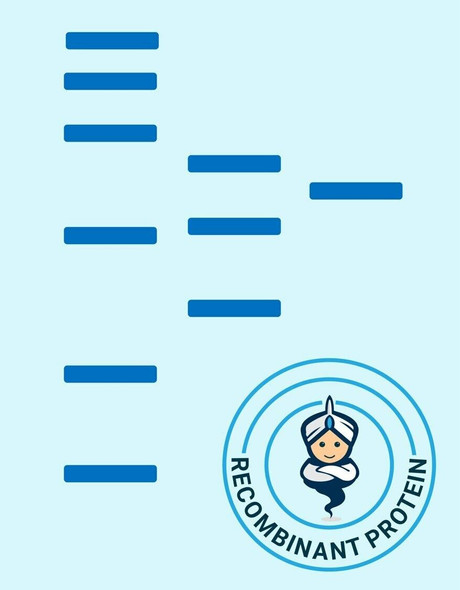Human CD93 Recombinant Protein (RPPB3101)
- SKU:
- RPPB3101
- Product type:
- Recombinant Protein
- Size:
- 5ug
- Species:
- Human
- Target:
- CD93
- Synonyms:
- CD93 Molecule
- CD93 Antigen
- Complement Component 1
- Q Subcomponent
- Source:
- Sf9 Insect cells
- Uniprot:
- Q9NPY3
Description
| Product Name: | Human CD93 Recombinant Protein |
| Product Code: | RPPB3101 |
| Size: | 5µg |
| Species: | Human |
| Target: | CD93 |
| Synonyms: | CD93 Molecule, CD93 Antigen, Complement Component 1, Q Subcomponent, Receptor 1, Complement Component 1 Q Subcomponent Receptor 1, Matrix-Remodeling-Associated Protein 4, Matrix-Remodelling Associated 4, C1q/MBL/SPA Receptor, C1qR(P), C1Qrp, C1QR1, MXRA4, CDw93, C1qR, C1q Receptor 1, DJ737E23.1, ECSM3. |
| Source: | Sf9 Insect cells |
| Physical Appearance: | Sterile filtered colorless solution. |
| Formulation: | CD93 protein solution (0.5mg/ml) containing Phosphate Buffered Saline (pH 7.4) and 10% glycerol. |
| Stability: | Store at 4°C if entire vial will be used within 2-4 weeks. Store, frozen at -20°C for longer periods of time. For long term storage it is recommended to add a carrier protein (0.1% HSA or BSA).Avoid multiple freeze-thaw cycles. |
| Purity: | Greater than 90.0% as determined by SDS-PAGE. |
| Amino Acid Sequence: | TGADTEAVVC VGTACYTAHS GKLSAAEAQN HCNQNGGNLA TVKSKEEAQH VQRVLAQLLR REAALTARMS KFWIGLQREK GKCLDPSLPL KGFSWVGGGE DTPYSNWHKE LRNSCISKRC VSLLLDLSQP LLPSRLPKWS EGPCGSPGSP GSNIEGFVCK FSFKGMCRPL ALGGPGQVTY TTPFQTTSSS LEAVPFASAA NVACGEGDKD ETQSHYFLCK EKAPDVFDWG SSGPLCVSPK YGCNFNNGGC HQDCFEGGDG SFLCGCRPGF RLLDDLVTCA SRNPCSSSPC RGGATCVLGP HGKNYTCRCP QGYQLDSSQL DCVDVDECQD SPCAQECVNT PGGFRCECWV GYEPGGPGEG ACQDVDECAL GRSPCAQGCT NTDGSFHCSC EEGYVLAGED GTQCQDVDEC VGPGGPLCDS LCFNTQGSFH CGCLPGWVLA PNGVSCTMGP VSLGPPSGPP DEEDKGEKEG STVPRAATAS PTRGPEGTPK ATPTTSRPSL SSDAPITSAP LKMLAPSGSP GVWREPSIHH ATAASGPQEP AGGDSSVATQ NNDGTDGQKV EHHHHHH |
CD93, is a receptor or else an element of a larger receptor complex for C1q, MBL2-mannose-binding lectin and SPA-pulmonary surfactant protein A. CD93 mediates the enhancement of phagocytosis in monocytes as well as macrophages upon interaction with soluble defense collagens. CD93 takes part in the intercellular adhesion. Furthermore, CD93 was expressed on (pre) plasmablasts/plasma cells, including long-lived plasma cells which demonstrated decreased cell cycle activity, high levels of isotype-switched Ig secretion, as well as modification of the transcriptional network. CD93 is vital for the maintenance of plasma cells in bone marrow niches.
CD93 Human Recombinant produced in Sf9 Baculovirus cells is a single, glycosylated polypeptide chain containing 567 amino acids (22-580 aa) and having a molecular mass of 59.3kDa (Migrates at 70-100kDa on SDS-PAGE under reducing conditions).CD93 is expressed with an 8 amino acid His tag at C-Terminus and purified by proprietary chromatographic techniques.
| UniProt Protein Function: | CD93: Receptor (or element of a larger receptor complex) for C1q, mannose-binding lectin (MBL2) and pulmonary surfactant protein A (SPA). May mediate the enhancement of phagocytosis in monocytes and macrophages upon interaction with soluble defense collagens. May play a role in intercellular adhesion. |
| UniProt Protein Details: | Protein type:Membrane protein, integral; Cell adhesion Chromosomal Location of Human Ortholog: 20p11.21 Cellular Component: cell surface; cytoplasmic membrane-bound vesicle; plasma membrane; integral to membrane Molecular Function:protein binding; complement component C1q binding; receptor activity; calcium ion binding; carbohydrate binding Biological Process: macrophage activation; cell-cell adhesion; viral reproduction; phagocytosis |
| NCBI Summary: | The protein encoded by this gene is a cell-surface glycoprotein and type I membrane protein that was originally identified as a myeloid cell-specific marker. The encoded protein was once thought to be a receptor for C1q, but now is thought to instead be involved in intercellular adhesion and in the clearance of apoptotic cells. The intracellular cytoplasmic tail of this protein has been found to interact with moesin, a protein known to play a role in linking transmembrane proteins to the cytoskeleton and in the remodelling of the cytoskeleton. [provided by RefSeq, Jul 2008] |
| UniProt Code: | Q9NPY3 |
| NCBI GenInfo Identifier: | 21759074 |
| NCBI Gene ID: | 22918 |
| NCBI Accession: | Q9NPY3.3 |
| UniProt Secondary Accession: | Q9NPY3,O00274, |
| UniProt Related Accession: | Q9NPY3 |
| Molecular Weight: | 68,560 Da |
| NCBI Full Name: | Complement component C1q receptor |
| NCBI Synonym Full Names: | CD93 molecule |
| NCBI Official Symbol: | CD93 |
| NCBI Official Synonym Symbols: | C1QR1; C1qRP; CDw93; ECSM3; MXRA4; C1qR(P); dJ737E23.1 |
| NCBI Protein Information: | complement component C1q receptor; C1qR; CD93 antigen; C1q receptor 1; C1q/MBL/SPA receptor; matrix-remodelling associated 4; matrix-remodeling-associated protein 4; complement component 1 q subcomponent receptor 1; complement component 1, q subcomponent, receptor 1 |
| UniProt Protein Name: | Complement component C1q receptor |
| UniProt Synonym Protein Names: | C1q/MBL/SPA receptor; C1qR; C1qR(p); C1qRp; CDw93; Complement component 1 q subcomponent receptor 1; Matrix-remodeling-associated protein 4; CD_antigen: CD93 |
| Protein Family: | Complement component C1q receptor |
| UniProt Gene Name: | CD93 |
| UniProt Entry Name: | C1QR1_HUMAN |










